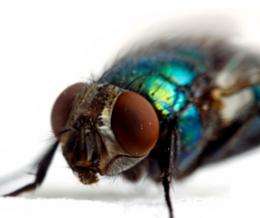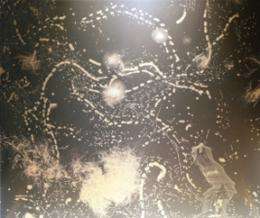The grim trail of bacteria left by flies in hot weather is revealed

(Phys.org) —The current hot spell of weather has seen increased activities by flies whether in the kitchen or across picnic food and barbecues.
It may make grim reading but every fly leaves a calling card in the form of bacterial deposits.
These deposits come not only from their legs, but also from the way that they eat - that is vomiting and then sucking up the resulting mixture.
Now scientists at the University of Surrey have mapped out just how much the pesky insects leave behind.
The research involved trapping blue bottle flies in a Petrie dish and then "growing" the resulting bacteria.
The results are a bit startling, for example, if a blue bottle has recently fed on faeces it may carry as many as six million bacteria on its feet.
Dr Simon Park, of the Department of Microbial and Cellular Sciences at the University of Surrey, said: "This exploration was inspired by the current hot weather and the theory that both flies and bacteria seem to benefit from it.
With higher temperatures you get more fly activity and more bacterial growth, they grow faster.
"The blue bottle fly, Calliphora vomitoria -the Latin name seems appropriate - is a very common and cosmopolitan insect, with which we share many of our environments.

"This fly seems to be equally at home feeding on dead animals, faeces and our carefully prepared food making it an unparalleled transmitter of transmitting disease.
"It prefers to swallow liquid food, and usually regurgitates ingested material in order to liquefy its meal and to facilitate digestion.
"In this manner flies can contaminate clean surfaces with approximately 0.1mg of food per landing. In addition, droplets of bacteria rich faeces may be deposited during feeding, about every four to five minutes."
Dr Park added "I trapped three blue bottle files in a large square plastic dish filled with solid bacterial growth media and allowed the flies to walk over the surface for just 10 minutes.
"As the flies travelled over the un-inoculated surface they left behind a trail of the bacteria in their footsteps. These tracks were at first invisible. However, after a day or so the bacteria grow into visible points or colonies that reveal the activity of the flies and the extent of their contamination.
"I must admit that even as a well-seasoned microbiologist, these images make me slightly queasy."
As for the flies they were not harmed in any way and let go to get on with their lives.
Dr Park's advice for this current spell of hot weather is to keep your food covered up to prevent flies landing on and to put food into your fridge wherever possible to prevent the growth of any harmful bacteria.
Fridges can struggle to maintain cold temperatures in this hot weather so check that yours is working efficiently.
Provided by University of Surrey


















